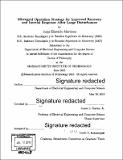Microrid operation strategy for improved recovery and inertial response after large disturbances
Author(s)
Elizondo Martinez, Jorge
DownloadFull printable version (31.97Mb)
Other Contributors
Massachusetts Institute of Technology. Department of Electrical Engineering and Computer Science.
Advisor
James L. Kirtley, Jr.
Terms of use
Metadata
Show full item recordAbstract
The electric grid is one of the major achievements of human kind. In the last hundred years it has grown from small clusters of generation and loads, into large networks containing millions of elements and spanning entire continents. Recently, the increasing deployment of distributed generators (DGs) has triggered a grid transformation from a rigid to a flexible and de-centralized structure. Microgrids are an essential element in this transformation because by grouping DGs and loads into controllable units, they can provide a coordinated response to maximize their impact on the grid. Microgrids are inherently different from the larger grid. This thesis shows how by challenging the paradigm of constant frequency and voltage operation, a new strategy can be implemented to achieve an improved response after large disturbances without compromising safety. Large disturbances are commonly encountered in the grid and disrupt the power balance that is required for a reliable operation. If the imbalance is large enough and the proper actions are not taken, then a blackout will occur, affecting millions of people and creating a severe economic impact. To demonstrate the advantages of the proposed operation strategy, two large disturbances are studied: a fault in the distribution network that creates a reactive power imbalance due to induction motor stalling, and a sudden change in generation or consumption that leads to a real power imbalance. In the first part, a framework is created to study fault events and then used to describe a fault recovery strategy that expands the stability region of the system. In the second part, the proposed operation strategy is presented as a new control technique that allows energy to be extracted from the induction motors in the system to achieve an inertial response and provide frequency regulation. All the results are validated using a microgrid experimental set-up that was built as part of this thesis.
Description
Thesis: Ph. D., Massachusetts Institute of Technology, Department of Electrical Engineering and Computer Science, 2016. Cataloged from PDF version of thesis. Includes bibliographical references (pages 177-183).
Date issued
2016Department
Massachusetts Institute of Technology. Department of Electrical Engineering and Computer SciencePublisher
Massachusetts Institute of Technology
Keywords
Electrical Engineering and Computer Science.